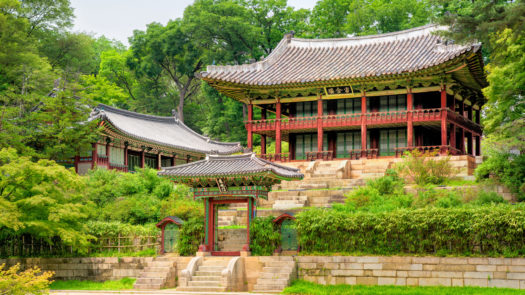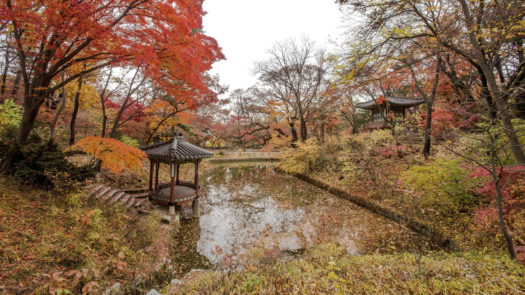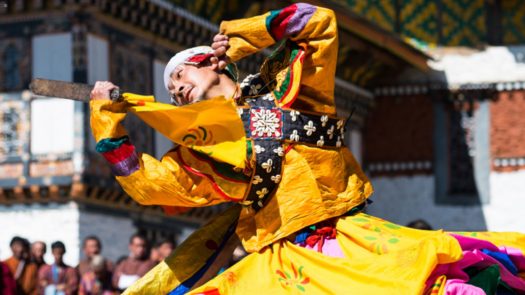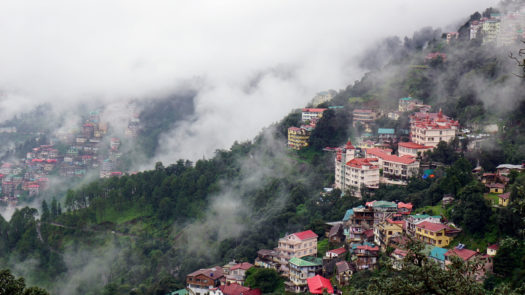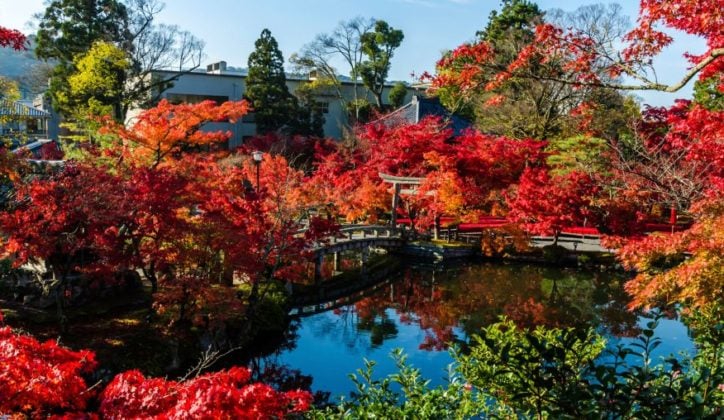Published on: January 14th, 2019
Last updated: July 28th, 2023
Asia is a vast continent, encompassing so many gems waiting to be discovered.
Autumn is one of the best times to travel to Asia; there is so much on offer, from lesser known festivals in Bhutan to stunning sidewalks dotted with autumn leaves in Japan and South Korea.
To help you make the most of your time in this fascinating part of the world, our expert travel designers have put together this guide on the best places to spend autumn in Asia.
Autumn leaves
Japan
Japan is famous for its springtime cherry blossoms, but come autumn these very same trees are carpeted in hues of fiery red, gold and orange. It is fairly difficult to predict when the leaves will appear in each city and how long they’ll stick around for, but Japan as a whole sees autumn colours from October to November. In imperial city Kyoto, the Tofukuji temple is one of Japan’s most stunning sacred sites, and truly comes to life when it’s surrounded by autumn foliage. The nearby Kiyomizu-dera Temple, originally built in 798, is also a must visit. The sweeping views over Kyoto from the main hall are particularly impressive in the autumn and attract visitors from across the country.
Neighbouring district Arashiyama provides a welcome respite from the bustling city. Surrounded by nature, this region features numerous interesting sites that are stunning during the autumn months. Okochi Sanso, a splendid mountain retreat that was once occupied by a silent screen actor, is a particular highlight – during autumn, the grounds are peppered with shades of orange. Taking a gentle stroll through the surrounding bamboo forests is a great way to explore the local nature.
South Korea
South Korea is also known for the infamous “sakura” season, but autumn also brings with it a host of bright and beautiful colours. In eclectic capital city Seoul, Changdeokgung Palace is a particular highlight. The second royal villa to be built in South Korea, Changdeokgung is the most well-preserved of the five remaining royal Joseon palaces.
In autumn, the public palace area, royal family residence building and surrounding gardens all look exceptionally stunning. The rear garden – boasting a gigantic 300 year old tree, small pond and pavilion – is the perfect place to relax in autumn. In the centre of the city, Yeouiseo-ro Road – which hosts the Yeouido Spring Flower Festival – is lined with burnt orange trees and falling leaves, perfect for photo opportunities.
Known as the ‘museum without walls,’ the historic city of Gyeongju is strewn with temples, tombs, pagodas and statues that take on a new life in the autumn. Notable sites in this historic city include Bulguksa Temple and the nearby Seokguram Grotto, which become illuminated by a backdrop of red, orange and gold hues during autumn. Anapji Pond is also a don’t miss destination in Gyeongju. During the autumn months, the tree laden mountains and beautiful flowers here give the picturesque landscape a new lease of life.
The man made Bomunho Lake, though, is the star of the show. Unlike other cities or towns where flowering trees are only found in certain areas, Gyeongju is packed with them. At hidden gem Bomunho Lake, the combination of stunning trees reflected in the waters and the graceful trees of Bulguksa Park makes for one of the most beautiful autumn scenes in South Korea.
The best of the rest
Festivals in Bhutan
Undiscovered Bhutan lies in the Eastern Himalayas, nestled between India and Tibet. The sole surviving Himalayan Buddhist Kingdom, Bhutan is a land filled with festivals and folklore. With the climate dry and sunny between October and May, this fascinating country hosts incredible festivals during autumn. Bhutan’s most rural and historic region, Bumthang, is home to quaint farming villages, an intricate dzong (fortress) and two national parks.
Every year, in mid-November, Bumthang’s ethereal landscape is brought to life with the Jambay Lhakhang Festival. The Jambay Lhakhang temple, built in 7th century AD by a Tibetan King named Songtsen Gampo is one of the oldest temples in the kingdom. Today, the Jambay Lhakhang Drup, or festival, is renowned as one of the most spectacular celebrations in the country. The festival begins with rich pageantry and atmosphere, celebrating Guru Rinpoche – the saint who brought Buddhism to Bhutan.
Lasting for five days, the celebrations involve villagers gathering around the temple in a spirit of festivity, celebration and deep worship. The Jambay Lhakhang festival also consists of unique masked dances performed by monks and laymen in colourful costumes. The highlight though, is the fire ritual – held in the evening, crowds gather to witness the devotional naked dance, thought to purify sins and guarantee a good harvest.
In Thimphu, Bhutan’s capital, the Coronation Day Festival (usually held in early November) marks the coronation ceremony of His Majesty the King, Jigme Khesar Namgyel Wangchuck. Held annually, Coronation Day is a public holiday in Bhutan, with celebrations usually lasting three days. The festival begins with the offering of a spiritual lamp before the portrait of the King and the singing of the national anthem. Dancing, games and cultural activities performed by locals in colourful costumes then follow, making for a delightful show.
Trekking in north India
India is a melting pot of landscapes and cultures, and the Himalayas are perfect for trekking come autumn. One of two divisions in the northern hill state of Uttarakhand, the Kumaon region is India’s best kept secret. With the best time to visit between October and mid April, autumn is the perfect time to explore this land of magnificent snow-capped peaks, verdant forests and alpine meadows.
Staying at mountain top hotel Shakti 360° Leti offers guests the chance to discover a side of India few people get to see. Many hikes run from this lodge, with everything from gentle walks to strenuous treks. For hiking enthusiasts, the steep trek up to Bunga Top is a rewarding excursion. A narrow path, or pagdangi, brings walkers up to a flat piece of pastureland. From here, there are stunning views over majestic mountain peaks – including the 7816m or 25,623ft Nanda Devi (the highest mountain covering land solely in India).
In the northern state of Himachal Pradesh, beautiful state capital Shimla is also worth a visit for keen walkers. Once the summer capital of the British Raj, Shimla today is a hill station surrounded by incredible verdant landscapes that are home to a UNESCO protected railway. Set amidst rolling mountains, Shimla remains as appealing as ever for adventurous travellers.
The Mashobra Valley is just as picturesque as Shimla, with beautiful trails winding through serene forests, traditional mountain villages and ancient temples. This full day 15 – 18 kilometre (9 – 11 mile) trek ends with a challenging 90-minute climb, so is best suited to experienced hikers. The climb is worthwhile though – once at the top, walkers are rewarded with an incredibly peaceful meadow and stunning apple orchard. From here, you can opt to be driven back to the nearby resort, or can climb down on foot to continue immersing themselves in the beautiful panoramas.
Nepal’s mountains
Similarly to northern India, Nepal is perfect for trekking during the autumn months. The best time for bucket list trips to Everest is post-monsoon season (late September through December), while the Annapurna circuit is best hiked from October through November, as well as from mid-March to mid-April. With Jacada, intrepid explorers can tick Everest off their bucket list with a culture, wildlife and mountain focused trip to Nepal.
On this trip, you can acclimatise to Everest by staying at a lodge with a relatively low altitude before trekking to Tashiga and travelling via private helicopter to Everest Base Camp. At an altitude of 5,364m, this incredible point from which mountaineering expeditions up the tallest mountain in the world begin. This exclusive excursion offers panoramic views over the Himalayas for a truly once in a lifetime experience.
Relax on the beaches of Sri Lanka
In Sri Lanka, idyllic beaches line the coast, and the Indian Ocean laps at beautifully serene shores. With the southern coast at its best between November and March, late autumn is a great time to visit the laid-back provinces of Tangalle. In Tangalle, travellers can spend their days relaxing on sands and exploring the stunning green landscape. With its coastline protected by a vast enclosing reef, Tangalle is one of Sri Lanka’s best spots for surfing, diving or whale watching. The area is also an important nesting site for turtles, so you may find yourself in the company of Green, Loggerhead, Leatherback, Olive Ridley and Hawksbill turtles under the pristine blue waters.
Cultural immersion in Myanmar
With November to March the best time to visit Myanmar, late autumn is an unrivalled time of year for a spot of cultural immersion. This is the best time of year to visit Bagan and Mandalay in particular, as these areas are extremely hot and dry throughout the rest of the year. Relatively undiscovered, Myanmar’s incredible festivals are a sight to behold. October and November see the most activity, so there’s always something going on in autumn. Held annually near Mandalay, the Kyaukse Elephant Dance Festival is particularly fascinating.
During this festival, a giant elephant is made out of bamboo or paper, with two of the local residents dancing inside it to the lively rhythm of drums. The dance pays homage to the Shwe Tha Lyaung pagoda and the festival as a whole is aimed at increasing the unity of the community. With Myanmar still a hidden gem, there is no better time to acquaint yourself with this captivating land.
Discover autumn in Asia
Feeling inspired? Our expert travel designers are always on hand to help you plan your autumn trip to Asia.






